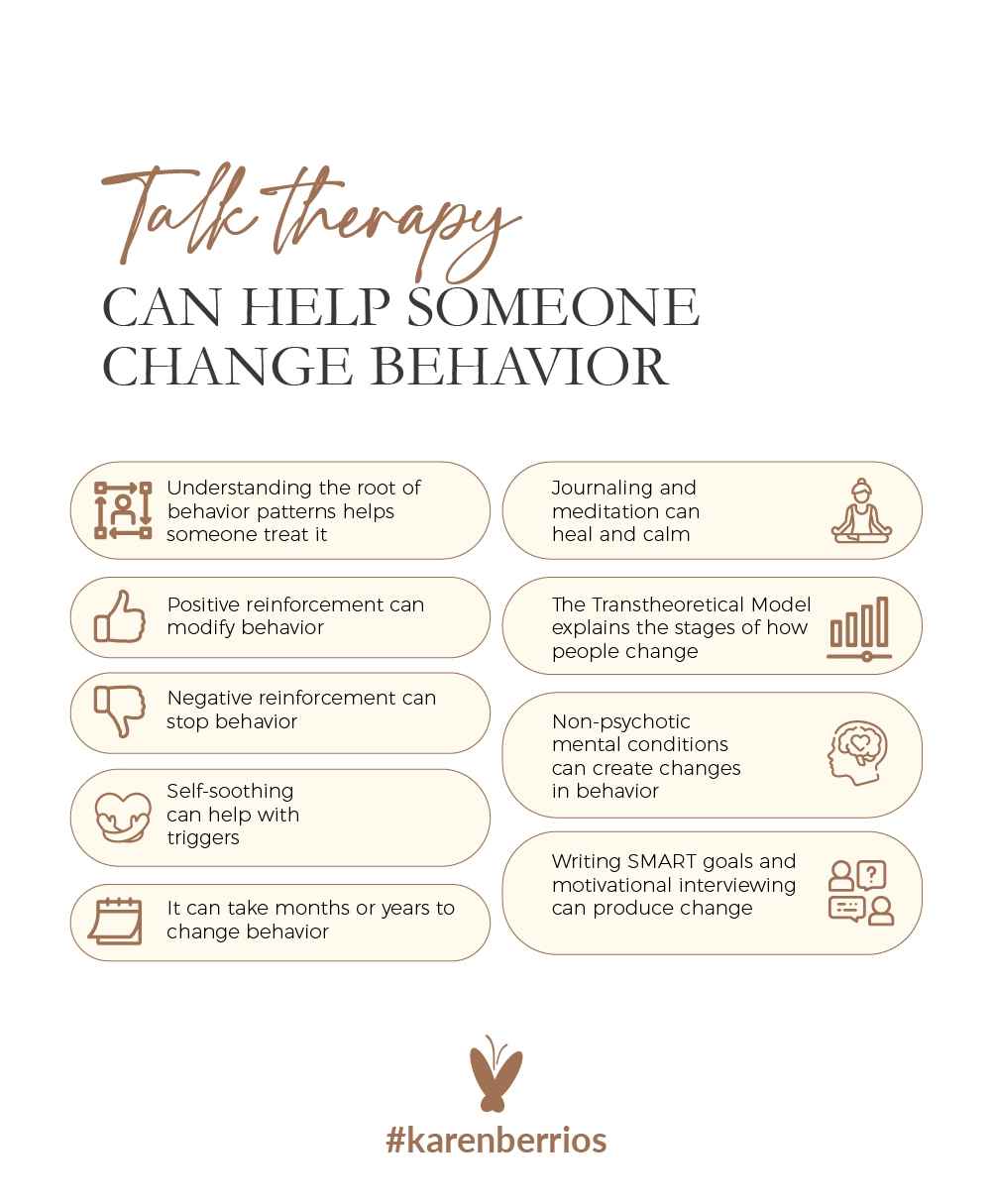

How to Rework Existing Narrative to Modify Behavior
Modify Behavior. What does it mean to change one’s narrative? And how does this contribute to positive change in someone’s life? When someone thinks of personal narratives, many of them think about personal beliefs or stories they have of themselves or others. These stories can be negative self-talk or subconscious wounds stemming from past failures.
On the other hand, some of these stories can be positive validation we have gotten from others. One’s beliefs about themselves and others, and their place in the world create patterns of behavior. Additionally, if these narratives have stemmed from childhood and need to be healed, they can impact someone’s behaviors as an adult.
One’s existing narratives can be a predictor for future events like success, relationship stability, and confidence. Thus negative ones can reveal the opposite. Changing behavior—especially once people have gotten older—may seem impossible. But there’s hope.
It’s worth identifying the problems causing the behaviors first in order to modify existing behavior and reward existing narratives. This helps pinpoint helpful treatments or therapies that can help someone overcome them. Someone may appear to behave odd or scary to someone. But delving under the surface, perhaps the person in question is being triggered and has not learned how to self-soothe.
The following are reasons someone could be undergoing personality and behavior changes, both including psychotic and non-psychotic mental disorders:
- Depression
- Anxiety
- Grief
- Addiction
- Loss
- Bullying
- Compulsions (OCD)
- Trauma
- Body dysmorphia
- Relocation
- Job or relationship stress
- Phobias
- Panic attacks
Another example could be someone experiencing more sadness or becoming more withdrawn than usual. Having a recent traumatic experience the person has not yet processed could be why. If they lost a loved one, and are depressed, then they can seem to have personality changes.
How Hard Is It to Modify Behavior?
At first glance, someone needing to modify the behavior may not be aware they need to change. This is why compassion for others can be helpful in holding space. It can take months or years to change. This depends on attachment to habits or deeply ingrained beliefs. People may realize they need professional tools to change existing narratives, but it can be hard to do on one’s own.
There are many healing options for someone who can begin to change their behaviors. First, people can get talk therapy, which helps with self-awareness. These tools involve a therapist asking probing questions in order to get to the core of any issues. They may try to discover:
- The meanings of patterns of behavior
- Unrealized effects of behavior
- Motivations for behavior
- Triggers or undoing triggers
While this list isn’t inclusive or everything they find, these are some examples. Therapists often use approaches like cognitive behavioral therapy, dialectical therapy, along with relational behavioral therapy to rewrite existing narratives. All 3 of these types of talk therapy function to correct behavioral patterns and re-establish positive and helpful ones.
Behavior modification, also called behavior therapy, is another tool in psychotherapy that goes under the surface. It helps someone change their behavior by focusing on specific aspects of personality changes.
Developed by B.F. Skinner, the overall process reduces maladaptive behaviors. Any harmful patterns of behavior can have negative impacts on relationships and people. With behavioral modification techniques, someone can both learn new behaviors and stop old and harmful ones.
Behavior Modification Therapy Techniques: Positive and Negative Reinforcement
The main element of behavior modification therapy and reworking existing narratives is using positive reinforcement to encourage change. What Is Positive reinforcement? Positive reinforcement for behavior modification can include a reward for a new habit. For example, someone may want to change a habit of oversleeping.
To encourage themself, they treat themselves to their favorite breakfast until they can successfully stop oversleeping. As a result, they can change their behavior and existing narrative.
Another example is someone recovering from addiction. They enter detox and have hands-on care. As a result, they are able to have a medically-monitored detox and have more pleasant withdrawal symptoms.
Then, they attend 12-Step groups, meet new friends, learn better relationship skills and connect. They develop better self-esteem, have counseling to understand triggers, and feel confident about sobriety.
Positive reinforcement for behavior modification can also create compulsions. For example, those who gamble get hooked on the hope of winning. This is the case if they won money when playing once, but the person wins every other time they gamble. They may feel the compulsion to keep trying to win.
However, negative reinforcement can also help someone modify behavior. According to the National Library of Medicine, negative reinforcement is “removing the stimulus as a consequence of behavior, but the positive outcome remains.”
This means someone can learn a behavioral pattern by doing it to avoid an uncomfortable outcome. A child may clean their room to avoid being scolded by their parents. This can occur in adults through behavior modification therapies done by professionals.
Behavior Modification Techniques: The Transtheoretical Model
The transtheoretical model for behavior modification techniques is a behavioral change model with specific goals. It also produces changes in behavior and modifies it. The in-depth process features 6 stages of change to create behavior changes in adults or kids. Someone has to progress through each one for transformation.
These are:
- Precontemplation
- Contemplation
- Preparation
- Action
- Maintenance
- Relapse
The Transtheoretical Model in More Detail
Each stage serves a unique purpose in the behavioral change model. Precontemplation is when someone doesn’t want to change. They may even be in denial about a problem. This stage keeps them comfortable and protects their ego. The end result is to encourage them to get help for recovery.
Next is the contemplation stage. Here, someone is more convinced they may have a problem that needs to be resolved. They may not be decisive and still need a push. The desired goal is for them to realize they should decide sooner than later to avoid them going back to stage 1.
Third is the preparation stage. Here, someone is more sure of their choice. Because of their decision, they begin to make changes or create new habits. Behavior modifications in this stage are supported by making lists or commitments to their goal. They may begin to show progress at this stage.
Stage 4 in the transtheoretical is the action stage. Someone is more clear and motivated to rewrite narratives and modify behavior. The person may be 6 months into their dedication to change their behavior at this point. They would follow their lists and can also be held accountable.
The maintenance stage means someone is disciplined and actively engaged in their modified behavior. Someone is no longer acting the same as before. Additionally, they may feel like a new person and have better moods and motivation. As well, someone may have to separate themselves from triggers or toxic people to preserve their new state.
Last is the relapse stage. Some people revert back to their old habits and need help getting unstuck. Therapy or interventionists can help them manage helplessness and regret in this stage. Someone can identify triggers to avoid another relapse.
How To Change Your Behavior and Self-Soothe
There is no 1-word answer on how to change behavior. They are all impacted by habits, inner wounds, and triggers. However, someone can journal for mental clarity and confront challenges faced. Secondly, someone can meditate to self-soothe nervousness and irritability. Deep breathing regulates the nervous system and provides inner stillness.
Nutrition can be a space to get vitamins for calm. Herbs like chamomile can create calm. Ashwagandha, passion flower and valerian root are known to offer a mellow effect on people. Drinking water and herbal teas can soothe the emotions and spiritual body. Setting intentions and following through can rework existing narratives. Additionally, being mindful of behaviors can help someone self-modify them.Making lists for accountability and motivation can inspire action. The SMART program emphasizes specific, measurable, achievable, relevant and time-bound goals for success. Lastly, talk therapy can greatly help someone discover and change their self-destructive behaviors. Here someone can access motivational interviewing, CBT, DBT, REBT and other tools. Change is possible and there are several affordable and quality tools for recovery.

hey there
I'm Karen!
I have found my cancer journey to be a positive and profound transformational experience. I’m inspired to share my healing journey here, and trust you’ll find hope, encouragement and purpose as you discover the healing power that lies within you.
Join
The Mailing List!
By signing up for my newsletter, you agree with our Privacy Policy and Terms & Conditions.



